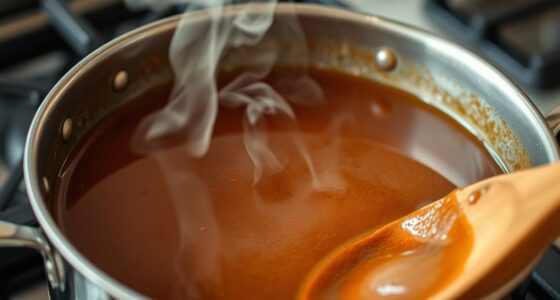Knowing whether to use fresh or low moisture mozzarella depends on your dish. Fresh mozzarella is soft, juicy, and best for salads, caprese, or melting on pizza for a delicate, creamy bite. Low moisture mozzarella is firmer with a sharper flavor, ideal for baked dishes like lasagna or pizza that need good melt and stretch. Understanding these differences guarantees you get the right texture and flavor every time—continue for more tips on storage and usage.
Key Takeaways
- Fresh mozzarella offers high moisture, a delicate flavor, and ideal for salads, eating straight, or adding to cold dishes.
- Low moisture mozzarella is firmer, aged, and melts reliably, making it perfect for baked dishes like pizza and lasagna.
- Use fresh mozzarella drained and stored in brine for salads and light recipes; choose low moisture for cooked, melted applications.
- Fresh mozzarella’s mild, milky flavor complements delicate ingredients; aged low moisture provides a richer, saltier taste for bold flavors.
- Proper storage and handling preserve each type’s texture and flavor, ensuring they perform well in their intended culinary uses.
Understanding the Texture and Moisture Content
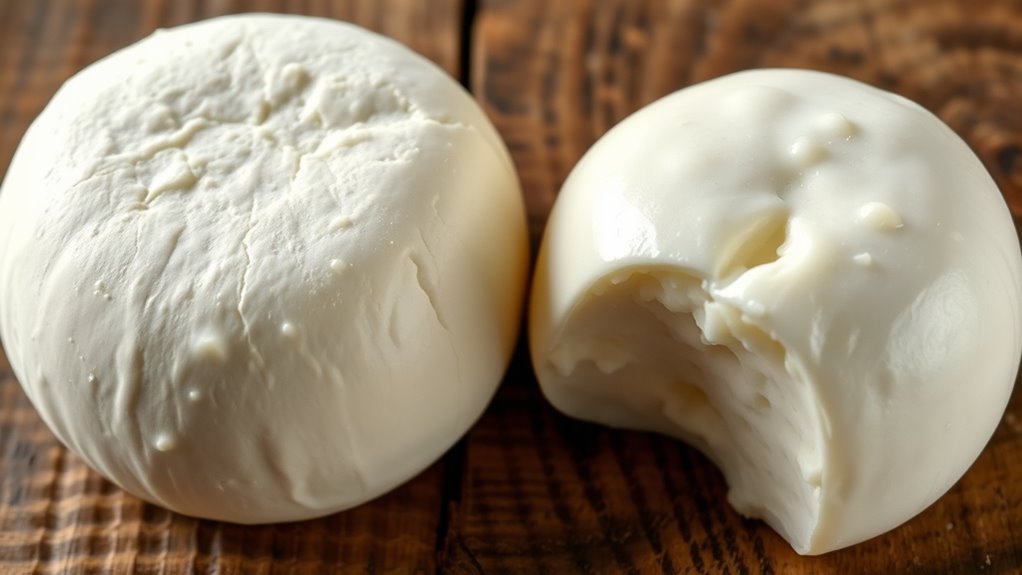
Understanding the texture and moisture content of mozzarella is essential to choosing the right type for your culinary needs. Fresh mozzarella has high moisture retention, making it soft, tender, and slightly creamy. This moisture gives it a delicate texture contrast that’s perfect for salads, caprese, or eating straight. In contrast, low moisture mozzarella has less water, resulting in a firmer, more elastic texture that holds up well when melted or baked. Knowing how moisture affects the cheese helps you select the right mozzarella for your dish. If you want a cheese that adds a fresh, juicy bite, fresh mozzarella is your go-to. For cooking that requires melting and stretching, low moisture mozzarella offers the ideal texture and moisture balance. Additionally, understanding practical support available for managing dietary choices can help optimize your culinary experience.
When to Choose Low Moisture Mozzarella for Cooking
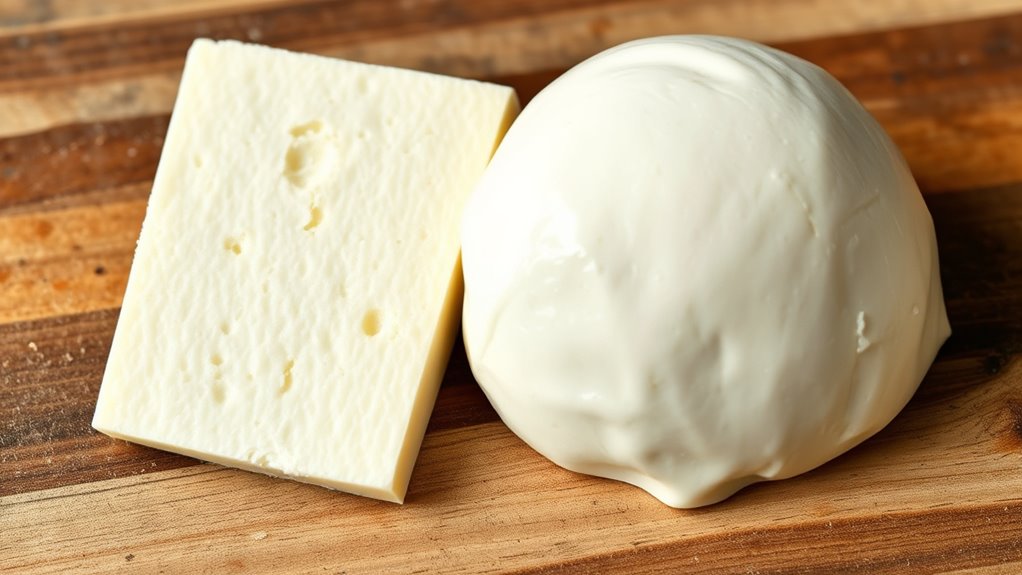
When you’re looking to achieve a consistent melt and stretch in your dishes, low moisture mozzarella is the best choice. Its ideal for recipes that require uniform heat distribution, like pizza and lasagna. Cheese aging plays a role here, as longer-aged low moisture mozzarella develops a firmer texture that melts smoothly without releasing too much moisture. Milk sourcing is also essential; cheeses made from high-quality, pasteurized milk tend to melt more evenly and maintain flavor integrity during cooking. Choose low moisture mozzarella when you need reliable performance in baked or heated dishes, especially where presentation matters. Its stable texture ensures your dish comes out with the perfect stretch and melt every time, making it a go-to for professional kitchens and home cooks alike. Business – Greek Sceptic
Best Uses for Fresh Mozzarella in Dishes
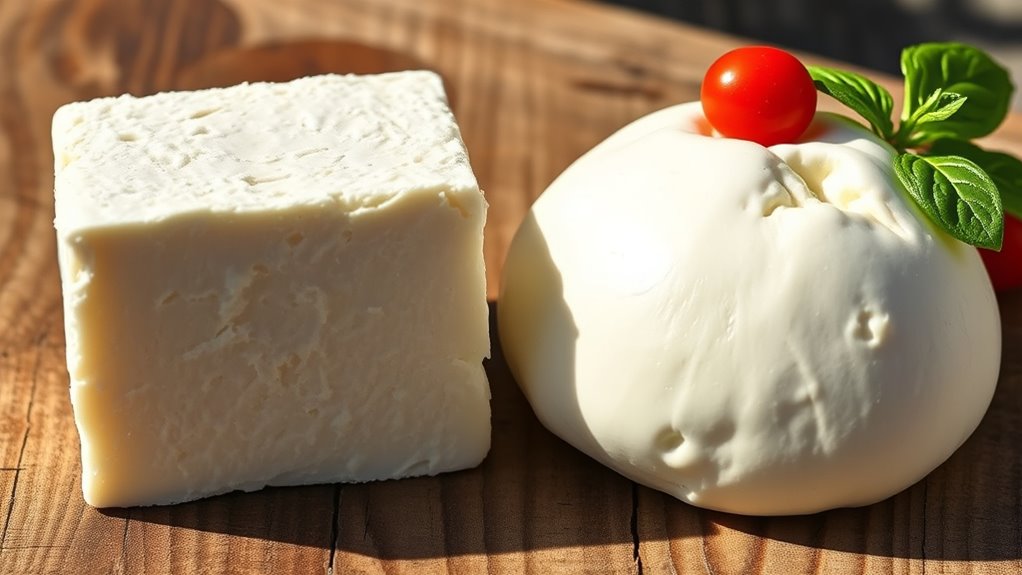
Fresh mozzarella shines in simple dishes like a classic Caprese salad, where its creamy texture complements fresh tomatoes and basil. It also makes a flavorful addition to pizzas, melting beautifully on top, and adds a fresh, tender bite to sandwiches and wraps. These uses highlight its versatility and ability to elevate everyday meals. Utilizing vertical storage solutions can also help keep your ingredients fresh and organized for quick, delicious preparations.
Caprese Salad Classic
A Caprese salad is the quintessential way to showcase fresh mozzarella’s delicate flavor and creamy texture. When selecting mozzarella, consider how mozzarella aging impacts its flavor; fresh mozzarella offers a mild, milky taste that pairs beautifully with ripe tomatoes and fresh basil. You want cheese that’s not overly aged, ensuring its subtle creaminess isn’t overshadowed. This classic dish highlights cheese pairing at its best—pairing the fresh mozzarella with bright olive oil, a splash of balsamic, and flaky sea salt enhances its natural qualities. The simplicity allows the cheese’s freshness to shine, making it ideal for showcasing the delicate flavor profile and creamy texture that only fresh mozzarella provides. It’s a timeless dish that celebrates quality ingredients. Color accuracy plays a role in how appealing and appetizing the dish appears on the plate.
Pizza Topping Essential
For pizza lovers, fresh mozzarella is an essential topping that delivers melty, creamy goodness with every slice. Its soft texture and delicate flavor make it perfect for highlighting the quality of cheese aging and dairy farming practices. When you use fresh mozzarella on pizza, you’re enjoying cheese that’s been carefully crafted, often from milk sourced from local farms, guaranteeing freshness and quality. Its high moisture content melts beautifully, creating that signature gooey layer that elevates your pie. Unlike low moisture varieties, fresh mozzarella adds a bright, milky taste that complements toppings like basil, tomatoes, and olive oil. For the best results, choose cheese from reputable dairy farms committed to traditional cheese aging, which enhances flavor and texture. This assures your pizza is both authentic and delicious. Additionally, incorporating fresh mozzarella can promote mental well-being, as the act of preparing and enjoying flavorful, wholesome ingredients can foster feelings of satisfaction and mindfulness.
Sandwich & Wraps
When incorporating mozzarella into sandwiches and wraps, its creamy texture and mild flavor can transform a simple dish into something special. Fresh mozzarella works best when it’s properly aged, offering a delicate balance of moisture and flavor that enhances your ingredients. Pay attention to packaging differences; fresh mozzarella often comes in water or vacuum-sealed packs, which impact its moisture content and ease of use. For sandwiches, choose a cheese that’s aged just enough to avoid excess moisture, preventing sogginess. Wraps benefit from mozzarella that’s firm yet still tender, adding a creamy bite without overpowering other flavors. Using the right type of fresh mozzarella ensures your sandwich or wrap maintains its structure and flavor, making every bite satisfying and fresh. Additionally, understanding tableware options can enhance presentation and overall dining experience.
Flavor Profiles and How They Influence Your Choice

Your choice between low moisture and fresh mozzarella depends on flavor balance and how they complement your dishes. Consider how their saltiness and creaminess levels impact taste, and think about how versatile each type is in different recipes. This understanding helps you select the perfect cheese to enhance your culinary creations. Additionally, knowing the offensive security measures involved in ethical hacking can guide you in choosing cheeses that withstand various cooking conditions.
Texture and Taste Balance
The balance between texture and taste plays a crucial role in choosing the right mozzarella for your dish. Fresh mozzarella offers a soft, creamy texture with high moisture preservation, delivering a delicate, milky flavor. Its cheese aging is minimal, which keeps the taste mild and fresh. Low moisture mozzarella, on the other hand, undergoes cheese aging that reduces moisture content, resulting in a firmer, more elastic texture. This process enhances its flavor, making it sharper and more pronounced. When selecting between the two, consider how the texture complements your recipe. Fresh mozzarella’s tenderness works well for salads and caprese, while low moisture mozzarella’s firmness holds up better in baked dishes. Striking the right balance ensures your dish achieves the desired flavor profile and mouthfeel. Additionally, understanding the characteristics of a healthy breakfast can inspire you to incorporate more nutritious ingredients alongside your cheese choices.
Salt and Creaminess Levels
Salt and creaminess levels considerably shape the flavor profiles of mozzarella, influencing how you perceive its richness and seasoning. Higher salt content enhances flavor, making the cheese more savory and well-rounded. Creaminess impacts mouthfeel and overall indulgence, especially in fresh varieties. When cheese ages, salt levels often increase, intensifying flavor and supporting flavor enhancement. Consider these points:
- Low-moisture mozzarella typically has a saltier, more concentrated taste due to cheese aging.
- Fresh mozzarella offers a milder, creamier profile that emphasizes its delicate texture.
- Adjusting salt and creaminess levels helps you match the cheese with your desired flavor intensity and recipe needs.
- Proper cheese storage methods help maintain optimal salt and creaminess levels, ensuring the cheese retains its intended flavor profile.
Your choice depends on whether you want a more pronounced flavor or a softer, subtler experience.
Versatility in Recipes
When selecting mozzarella for a recipe, understanding how its flavor profile influences versatility can help you achieve the desired taste and texture. Cheese aging plays a key role here; fresh mozzarella offers a mild, delicate flavor ideal for subtle flavor pairing, while low moisture mozzarella develops a richer, more complex taste through aging. This depth makes it suitable for baked dishes, melting tasks, or adding a savory punch. Consider how the cheese’s flavor profile complements other ingredients—fresh mozzarella pairs well with light herbs and tomatoes, whereas aged varieties stand up to bold spices and roasted vegetables. Knowing these differences enables you to choose the right mozzarella to enhance your dish’s overall flavor, ensuring your recipe turns out just as you envision. Flavor profiles play a significant role in how well mozzarella integrates into different recipes.
Common Mistakes and Misconceptions to Avoid
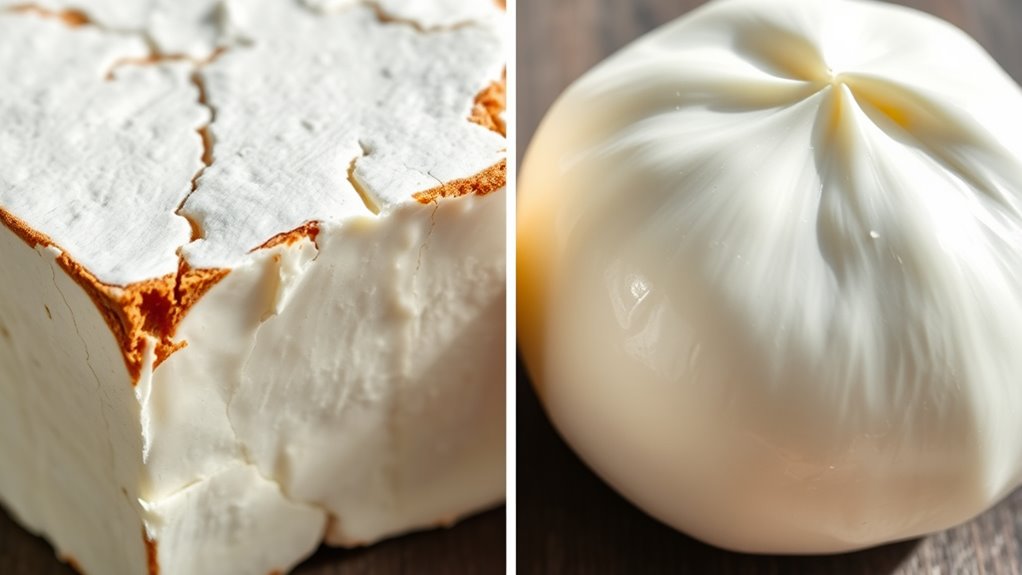
Many home cooks make the mistake of assuming all mozzarella types can be used interchangeably without adjustments. Understanding cheese aging and dairy processing is essential to avoid this. First, don’t assume fresh mozzarella works well for baked dishes without draining excess moisture, as high water content can affect texture. Second, don’t forget that low moisture mozzarella has undergone more cheese aging, which impacts melting and flavor, so it’s better suited for melting applications. Third, avoid substituting one for the other without considering moisture levels and processing differences, as this can lead to disappointing results. Recognizing these distinctions helps you select the right mozzarella for each dish, ensuring ideal flavor and texture. Misunderstanding cheese aging and dairy processing often leads to mistakes, so pay attention to the type you choose.
Tips for Storing and Handling Each Type Effectively

To keep mozzarella at its best, proper storage and handling are essential. For fresh mozzarella, store it in its original brine or in an airtight container with a little water to keep it moist. Change the water daily and keep it refrigerated. When handling fresh mozzarella, use clean utensils and avoid excessive squeezing to prevent damage. Low-moisture mozzarella should be wrapped tightly in plastic wrap or stored in an airtight container to prevent drying out. Handle it with dry hands or utensils to avoid adding moisture that can cause mold. Both types benefit from proper temperature control and minimal exposure to air. Following these storage considerations and handling techniques guarantees your mozzarella stays fresh, flavorful, and ready for use whenever you need it.
Frequently Asked Questions
How Do Different Brands Impact Mozzarella Quality and Taste?
Different brands markedly impact mozzarella quality and taste because they vary in cheese preservation methods and ingredient quality. You’ll notice that some brands maintain flavor consistency better, ensuring each bite tastes fresh and creamy. Others might use additives or different aging techniques, affecting the cheese’s texture and flavor profile. Choosing reputable brands helps you enjoy mozzarella with reliable quality and a balanced flavor, making your dishes consistently delicious.
Can Low Moisture Mozzarella Be Used in Desserts?
You can definitely use low moisture mozzarella in desserts—you just need to know how. As they say, “don’t judge a book by its cover,” so don’t dismiss it for sweet dishes. It works well for cheesecake pairing or as an ice cream topping when melted or shredded. Its firmer texture adds a unique twist, making your dessert both delicious and visually appealing. Just balance flavors, and it’ll shine!
What Are the Health Differences Between Low Moisture and Fresh Mozzarella?
You’ll find that dairy processing affects the nutritional comparison between low moisture and fresh mozzarella. Low moisture mozzarella generally has higher sodium and preservatives, which can impact your health if consumed excessively. Fresh mozzarella offers more natural fats and slightly higher calcium levels, making it a better choice for wholesome eating. Overall, consider your dietary needs and check labels to make an informed decision about which mozzarella suits your health goals.
How Does Aging Affect Mozzarella’s Texture and Flavor?
Aging transforms mozzarella more dramatically than you’d believe, like turning a simple cheese into a flavor powerhouse. During cheese maturation, the texture firms up, becoming more crumbly or chewy, while flavor development deepens, adding complexity and richness. You’ll notice a sharper, more nuanced taste as the cheese ages, making it perfect for pairing or melting. So, aging isn’t just a process; it’s a journey that elevates mozzarella’s character to new heights.
Is There a Vegetarian Alternative to Traditional Mozzarella?
Yes, you can find vegetarian options like vegan cheese and plant-based alternatives that mimic traditional mozzarella. These cheeses are typically made from ingredients like cashews, soy, or coconut oil, offering a similar texture and flavor. You’ll appreciate these options if you’re seeking a dairy-free or plant-based alternative. They work well in pizzas, salads, and sandwiches, providing a delicious, ethical, and sustainable choice for mozzarella lovers.
Conclusion
Now that you know the differences, selecting the right mozzarella becomes a breeze—like choosing a trusty quill over a feathered pen. Whether you prefer the meltiness of low moisture or the fresh, milky charm of the other, your dish will shine. Keep these tips in mind, handle each type with care, and avoid rookie mistakes. With a little knowledge, you’re ready to craft a culinary masterpiece that even a wise old chef from the Renaissance would tip his hat to.



